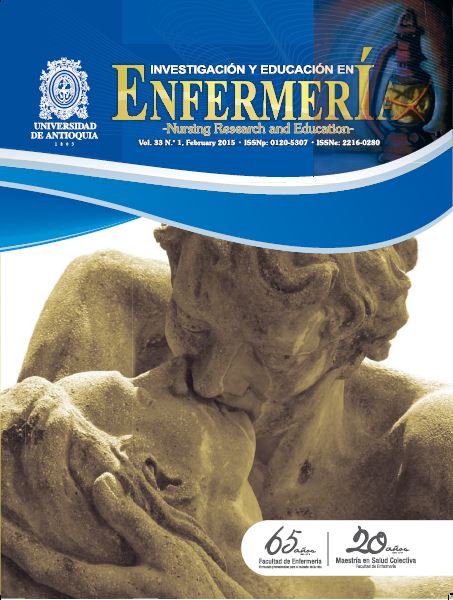Material world and social recognition: Nursing care in Spain (1855-1955)
DOI:
https://doi.org/10.17533/udea.iee.21897Keywords:
History of nursing, working environment, social desirability.Abstract
Objective. This study sought to recognize the active and symbolic role played by the objects from the material world for nursing care in Spain between 1855 and 1955.
Methodology. This was a historical study using grounded theory procedures. The information sources were eight handbooks for the training of caring professionals published in Spain, during the period of interest. The information was gathered from March 2012 to June 2013. During this period, the sources were fully revised and index cards with bibliographic information, description of instruments, and analysis were elaborated; methodological and analytic memoranda were written. Forty-five procedures and 360 material objects were registered.
Results. The categories “principal and secondary objects” and “guarded objects” reveal the influence exerted by the objects from the material world for care.
Conclusion. In Spain, between 1855 and 1955, nursing care was carried out within a scenario comprised of objects with secondary status and situated within the periphery of care, as well as by guarded objects that professionals could not use. This material world influenced the social recognition of professional caregivers at the time and the visibility of their work.
How to cite this article: Arredondo-González CP, De la Cuesta-Benjumea C, Ávila –Olivares JA. Material world and social recognition: nursing care in Spain (1855-1955). Invest Educ Enferm. 2015; 33(1):
Downloads
References
(1) Pinch T. Technology and Institutions: Living in a material world. Theor Soc. 2008; 37(5):461-83 3
(2) Blumer H. Symbolic Interactionism: perspective and method. New Jersey: Englewood Cliffs, Prentice Hall; 1969.
(3) Santos K M, Stein B D, De Moura S L. Tecnologias de Cuidado em Saùde e Enfemagem e Suas Perspectivas Flosóficas. Texto Contexto –Enferm. 2006; 15 (Esp):178- 85.
(4) González RA. La experiencia del otro: una introducción a la etnoarqueología. Madrid: Ediciones Akal; 2003.
(5) Hodder I. Interpretación en Arqueología. Corrientes actuales. 2ª ed. Barcelona: Editorial Crítica S.A; 1994.
(6) Dobres MA. Technology and Social Agency: Outlining a Practice Framework for Archaeology. London: Blackwell Publishing; 2000.
(7) Sandelowski M. Devises & Desires Gender. Technology and American Nursing. Chapell Hill: The University of North Carolina Press; 2000.
(8) Mannoni T, Giannichedda E. Arqueologia. Marteriales, Objetos y Producciones. Barcelona: Ariel; 2006.
(9) Camayo PR. Proceso de profesionalización: Evolución de la denominación de enfermería. Híades. 2008; 2(10);903-20.
(10) Castelo DM, Curiel BG, Fernández MF, Martínez CM. A cerca del origen de la profesión de enfermería en España: El problema de la identidad profesional. Híades. 2008; 2(10):843-53.
(11) Parrilla SJ, García GC. Análisis de la Enfermería en España. Desde finales del siglo XIX hasta su integración en la Universidad. Híades. 2004; (9):407-24.
(12) González CC. Metodología y fuentes para el estudio de la historia de la Enfermería contemporánea. Híades. 2008; 2(10):879-88.
(13) Caplow T. The Sociology of Work. Minneapolis: University of Minnesota Press; 1954.
(14) Dumêt FJ, Sato T A, Romano M C, Veiga, KC, Santos T M. Qualidad do gerenciamiento como tecnología do cuidar. Texto Contexto-Enferm. 2000; 9(1):153-6.
(15) Nietsche EA, y Leopardi MT. Tecnologia emancipatória: uma perspectiva de transformação da práxis de enfermagem. Texto Contexto-Enferm. 2000; 9(1):25-41.
(16) Colliére M. Promover la vida. De la práctica de las mujeres cuidadoras a los cuidados de Enfermería. Madrid: McGraw- HILL/Interamericana; 1993.
(17) Del Castillo GM. Perfil profesional de la enfermera española a lo largo de la historia. Híades. 2008; 2(10):977-83.
(18) Siles J. Historia de la Enfermería en España. Madrid: Difusión y Avances en Enfermería; 2011.
(19) Hernández CJ. Historia de la enfermería. Un análisis Histórico de los cuidados de enfermería. Madrid: McGraw Hill-Interamericana; 1999.
(20) Nogales E A. Pensamiento Enfermero e Historia. Necesidad de Vertebración Filosófica e Histórica en Enfermaría. Cult Cuid. 2006; 10(20):14-21.
(21) Taylor B, Francis K. Qualitative Research in the Health Sciences. Methodologies, Methods and Processes. Abington (UK): Routledge; 2013.
(22) Charmaz K. The Power and Potential of Grounded Theory. Medical Sociology online [Internet]. 2012 [cited October 2, 2013]; 6(3). Available from: http://www.medicalsociologyonline.org/resources/Vol6Iss3/MSo-600x_The-Power-and-Potential-Grounded-Theory_Charmaz.pdf
(23) Elliot JH. Haciendo Historia. Madrid: Santillana; 2012.
(24) Escobar CE. De los miasmas al germen. El descubrimiento de la entidad etiológica. Génesis y desarrollo en Antioquia. Iatreia.1996; 9(1):32-6.
(25) Muruani M. Trabajo y el empleo de las mujeres. Madrid: Fundamentos; 2002.
(26) Lemmonier P. Mundane objects. Materiality and non-verbal communication. Walnut Creek: Left Coast Press; 2012.
Downloads
Published
How to Cite
Issue
Section
License
Derechos de propiedad / Direitos de Propriedade
English: If the article is accepted for publication, all copyright will be of exclusive property of Investigación y Educación en Enfermería. The text and the graphics included in the publication are exclusive responsibility of the authors and not necessarily reflect the thought of the Editorial Committee.
Español: Si el artículo es aprobado para publicación, todos los derechos son de propiedad de Investigación y Educación en Enfermería. El texto y las gráficas incluidas en la publicación son de exclusiva responsabilidad de los autores y no necesariamente refleja el pensamiento del Comité Editorial.
Português: Se o artigo for aceito para publicação, todos os direitos autorais serão de propriedade exclusiva de Investigación y Educación en Enfermería. O texto e os gráficos incluídos na publicação são de responsabilidade exclusiva dos autores e não refletem necessariamente o pensamento do Comitê Editorial.















